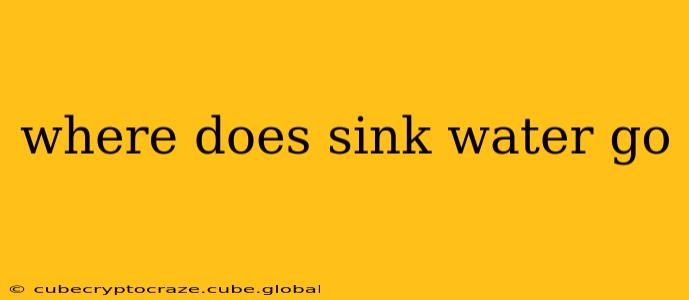Have you ever wondered what happens to the water after you wash your hands or do the dishes? It's a question that seems simple, but the answer reveals a fascinating journey through your home's plumbing system. This comprehensive guide explores the path of your sink water, answering common questions along the way.
What Happens to the Water After I Turn Off the Faucet?
Once you turn off your faucet, the water, now carrying away waste and potentially soap or detergent, begins its descent through the drainpipe. This pipe is usually made of PVC (polyvinyl chloride) or ABS (acrylonitrile butadiene styrene) and is designed to efficiently carry wastewater away from your sink. The slope of the pipe is crucial; a slight incline ensures gravity helps move the water along.
How Does the Water Get From My Sink to the Sewer?
The water from your sink first travels through a P-trap, a curved section of pipe beneath the sink. This crucial component serves a vital purpose: it acts as a water seal, preventing sewer gases from entering your home. The water trapped in the P-trap creates a barrier, keeping unpleasant odors at bay.
From the P-trap, the wastewater flows into the drainpipe, which connects to the main drain line of your home. This main drain line, usually larger in diameter than the individual sink drains, collects wastewater from all fixtures (sinks, showers, toilets, etc.) in your home.
Finally, the wastewater from your home's main drain line eventually flows into the municipal sewer system. This vast network of pipes carries wastewater to a wastewater treatment plant.
What About Grease and Food Scraps?
Many people worry about grease and food scraps going down the drain. While small amounts might initially pass through, larger quantities can solidify in your pipes, leading to clogs. This is why it's crucial to avoid pouring grease down the sink. Use a grease trap if you're dealing with significant grease amounts, and dispose of food scraps properly in the trash or garbage disposal (if you have one, and use it responsibly). Regular cleaning of your drains with drain cleaners (used sparingly and according to instructions) or a plumbing snake can help prevent clogs.
Where Does the Sewer Water Go After Leaving My House?
From your home's connection to the main sewer line, the wastewater travels to a wastewater treatment plant. These plants use a complex process to remove pollutants and contaminants from the water before it's safely returned to the environment. The treatment process typically involves several stages, including screening, primary treatment (settling), secondary treatment (biological breakdown), and disinfection. The treated water is then often discharged into rivers, lakes, or oceans.
Does My Sink Water Go to the Same Place as Toilet Water?
Yes, in most homes, both sink water and toilet water eventually end up in the same sewer line and, subsequently, the same wastewater treatment plant.
Can I Put Everything Down the Sink Drain?
No, absolutely not. Avoid pouring grease, oil, or chemicals down your drain. These substances can damage pipes and harm the environment. Always dispose of hazardous materials properly, following local regulations.
What Happens If My Drain Gets Clogged?
A clogged drain can lead to unpleasant backups and potential water damage. Minor clogs can sometimes be resolved with a plunger or drain cleaner. However, for more severe clogs, it's best to call a professional plumber. They have specialized tools and expertise to clear blockages effectively and prevent future problems.
This detailed explanation should answer your question about where sink water goes and highlight the important role your home's plumbing system and wastewater treatment plants play in maintaining sanitation and environmental health. Remember responsible disposal practices to keep your drains flowing smoothly and the environment clean.
